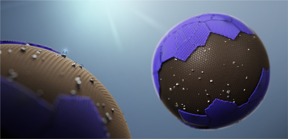Home > Press > Organic water splitters get a boost
 |
| A KAUST-led international team has developed a nanoparticle photocatalyst that can generate hydrogen fuel from water more efficiently than their standard inorganic semiconductor counterparts.
CREDIT © 2022 KAUST; Ivan Gromicho |
Abstract:
Organic semiconductor-based photocatalysts conceived by a KAUST-led team could make hydrogen easier to generate from water using sunlight.
Organic water splitters get a boost
Thuwal, Saudi Arabia | Posted on June 10th, 2022
Sunlight is the most abundant source of renewable energy, but its inability to produce consistent energy levels over time means it cannot meet energy needs on demand. A promising option is to store solar energy as clean hydrogen fuel, derived from water by the so-called hydrogen evolution reaction in the presence of a light-responsive catalyst.
Most hydrogen evolution photocatalysts consist of inorganic semiconductors, such as titanium dioxide, that almost exclusively absorb ultraviolet light. But because ultraviolet light represents less than five percent of the solar spectrum, the resulting photocatalysts are not efficient enough for commercial use.
An international team led by Iain McCulloch and postdoc Jan Kosco were able to develop organic semiconductor-based photocatalysts because they could tune the semiconductor bandgaps which define the absorption wavelength range to absorb visible light.
All else being equal, the more light a photocatalyst absorbs, the more efficiently it can convert solar energy into hydrogen, Kosco explains. So, it is important to develop photocatalysts that are active over a broad range of ultraviolet-visible-infrared wavelengths to maximize light absorption.
When exposed to light, semiconductor-based photocatalysts generate pairs of electrons and positively charged holes, or excitons, which dissociate into free charges that subsequently can migrate to the photocatalyst surface and drive hydrogen evolution. However, excitons are tightly bound in typical single-component organic semiconductors, which restricts charge separation and photocatalytic efficiency.
The researchers combined electron donor and acceptor semiconductor materials to form nanoparticles, known as heterojunction photocatalysts, whose overall bandgap configuration promotes exciton dissociation at the semiconductor interface.
This is analogous to the bulk heterojunction used in organic solar cells, Kosco says. We, therefore, generated more charges in these nanoparticles than in those composed of individual semiconductors, which improved hydrogen production.
Unexpectedly, the heterojunction resulted in extremely long-lived photogenerated charges in the nanoparticles.
Charges typically recombine on the microsecond timescale, but we observed charges in our nanoparticles even a few seconds after photoexcitation, which is exceptionally long for photogenerated charges in organic semiconductors, Kosco says. This is critical for catalyst performance because it gives more time for the charges to take part in relatively slow redox reactions at the nanoparticle surface, he adds.
The team is now exploring ways to apply the new photocatalysts to water splitting Z-schemes, where hydrogen and oxygen evolution photocatalysts are coupled to simultaneously drive the production of hydrogen and oxygen. They are also developing organic semiconductor photocatalysts for oxygen evolution.
####
For more information, please click here
Contacts:
Media Contact
Michael Cusack
King Abdullah University of Science & Technology (KAUST)
Office: 009660128083040
Expert Contact
Jan Kosco
King Abdullah University of Science and Technology (KAUST)
Copyright © King Abdullah University of Science & Technology (KAUST)
If you have a comment, please Contact us.
Issuers of news releases, not 7th Wave, Inc. or Nanotechnology Now, are solely responsible for the accuracy of the content.
News and information
![]()
University of Illinois Chicago joins Brookhaven Lab’s Quantum Center June 10th, 2022
Possible Futures
![]()
Electron-phonon coupling assisted universal red luminescence of o-phenylenediamine-based CDs June 10th, 2022
![]()
Marching to the Cadence of Electronics: Innovation A new paper in Nature validates technology developed by John Bowers and collaborators June 10th, 2022
![]()
Small materials may be key to reducing cardiovascular disease deaths, researchers say June 10th, 2022
![]()
Decoding a key part of the cell, atom by atom June 10th, 2022
Discoveries
![]()
Electron-phonon coupling assisted universal red luminescence of o-phenylenediamine-based CDs June 10th, 2022
![]()
Marching to the Cadence of Electronics: Innovation A new paper in Nature validates technology developed by John Bowers and collaborators June 10th, 2022
![]()
Small materials may be key to reducing cardiovascular disease deaths, researchers say June 10th, 2022
![]()
Decoding a key part of the cell, atom by atom June 10th, 2022
Announcements
![]()
Bumps could smooth quantum investigations: Rice University models show unique properties of 2D materials stressed by contoured substrates June 10th, 2022
Interviews/Book Reviews/Essays/Reports/Podcasts/Journals/White papers/Posters
![]()
Decoding a key part of the cell, atom by atom June 10th, 2022
Energy
![]()
Engineering piezoelectricity and strain sensitivity in CdS to promote piezocatalytic hydrogen evolution May 13th, 2022
![]()
USTC found a pathway to high-quality ZnSe quantum wires April 8th, 2022
![]()
Three dimensional Mn-doped NixSy/Ni2P and Mn-doped Ni2O3/Ni2P nanosheets as efficient electrocatalysts for alkaline overall water splitting April 8th, 2022
Water
![]()
The future of desalination? A fast, efficient, selective membrane for purifying saltwater May 13th, 2022
![]()
The deformation of the hydrogel is used to measure the negative pressure of water April 22nd, 2022










